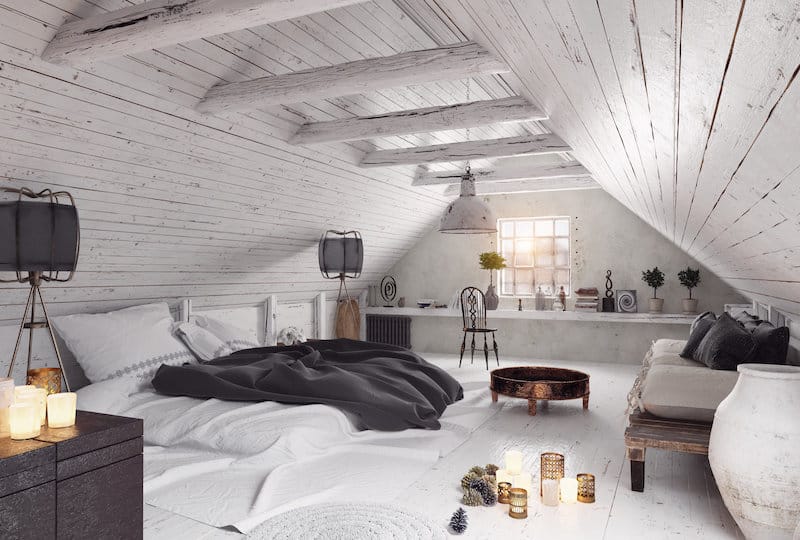
Zastolskiy Victor/Shutterstock
Attic Bedroom Ideas for Cozy Retreats
As children we looked up to the attic as a place of mystery and infinite possibility.
Who knew what lay within those cobwebbed boxes and among the discarded familial memorabilia, what secrets and treasures were ours to unlock?
While me may have abandoned such intrigue to the days of childhood fancy, the attic has no doubt retained its allure and comforting confines, making it the perfect bedroom abode for the adult with a penchant for exclusive solitary havens.
Open or intimate, bright or dimly woodsy, the attic is truly a canvas awaiting your unique vision. From lived-in farmhouse familiarity to the sleek vibes of a chic metropolitan loft, the attic bedroom provides ample space and endless potential, with no inspiration too impossible to tangibly realize. Whether you prefer simplicity or a more conceptual theme, there is no limit to the attic’s promise, just as it seemed in your childhood explorations. Wood, stone, wallpaper, and countless textiles are just a few of the attic bedroom’s magic tools; the place where you lay your head is ultimately in your hands.
Perfect for a master bedroom or charming guest suite, these cool attic bedroom ideas promise privacy and unmatched originality. Why relegate this wonderful space to a dusty (and sometimes spooky) storage capacity, when it can be lived and dreamed in day in and day out? Now is the perfect time to ascend and asses your own attic space, for your own midsummer night’s dream is just a season away.
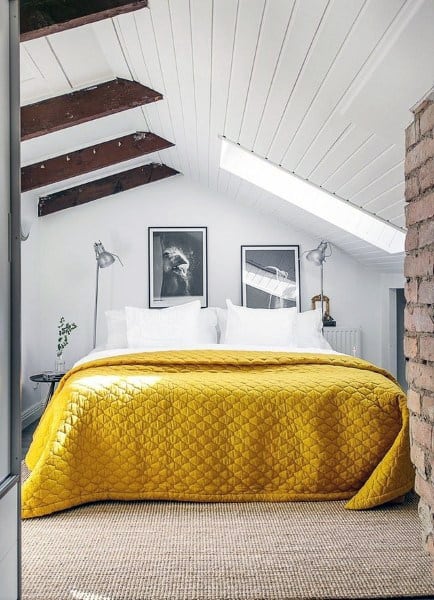
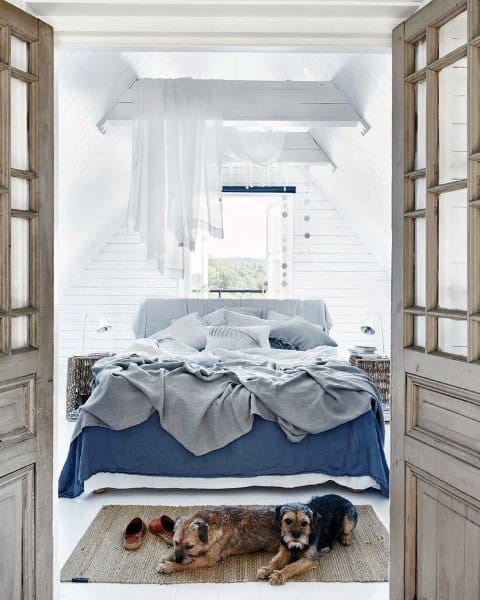
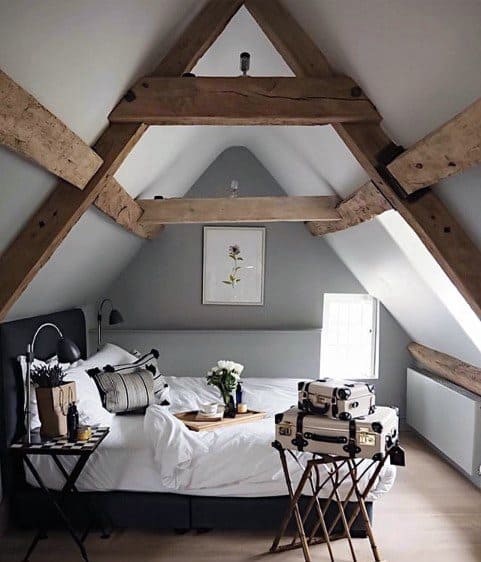
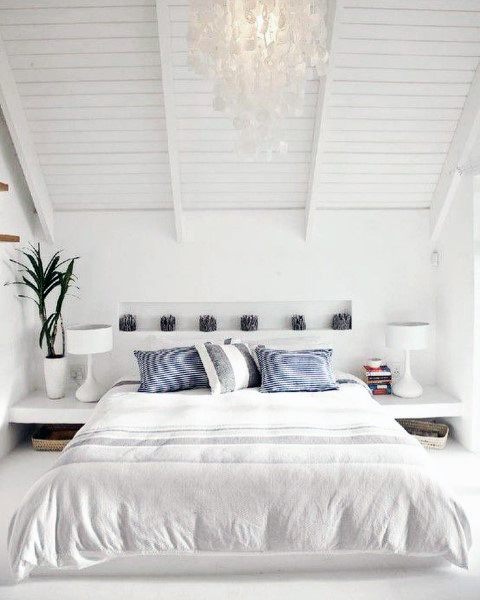
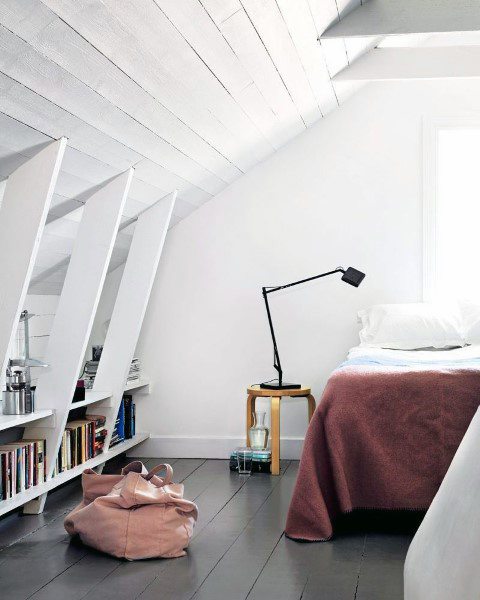
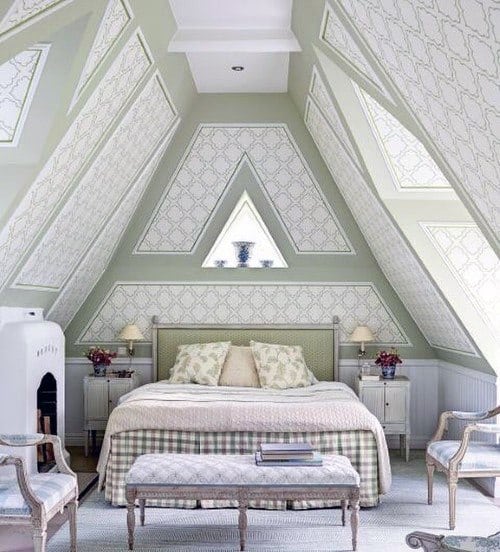
FAQs
Is an attic bedroom a good idea?
An attic can be a great space to convert into a bedroom, offering a unique and cozy environment. The sloped ceilings, skylights, and potential for added privacy make it appealing. However, certain factors such as insulation, lighting, and structural integrity should be carefully considered before making the transformation.
Is it warm in the attic?
Attics can get quite warm, especially during summer months, due to heat rising from the lower levels of the home. Proper insulation and ventilation are crucial to keeping the space comfortable. Adding air conditioning or fans can help regulate temperature and prevent overheating.
What is the 7 and 7 rule for attics?
The “7 and 7 rule” refers to the minimum height and width requirements for an attic to be used as a livable space, often for a bedroom. According to this rule:
- The ceiling height must be at least 7 feet (2.13 meters) in a portion of the room.
- There must be at least 7 feet of unobstructed floor area in the middle of the room. This ensures that the space is comfortable and meets building codes for safety.
How to make an attic bedroom look nice?
To make an attic bedroom look nice, focus on maximizing natural light, using light colors to make the space feel larger, and incorporating stylish furniture that complements the sloped ceiling. Here are a few ideas:
- Use built-in storage solutions to save space.
- Install large windows or skylights to brighten up the room.
- Add soft textures like rugs, curtains, and throw pillows to create a cozy atmosphere.
- Use multifunctional furniture such as fold-out desks or wall-mounted shelves.
Can I turn an attic into a bedroom?
Yes, you can turn an attic into a bedroom, but there are some important steps to follow:
- Ensure structural integrity: Have the space assessed to ensure the floor and ceiling can support the weight of furniture and people.
- Insulate properly: Make sure the attic is well-insulated to regulate temperature.
- Check local regulations: Make sure to comply with local zoning and building codes, including the 7 and 7 rule and any other requirements for living spaces.
- Install proper lighting: Attic rooms often have limited natural light, so you’ll need adequate artificial lighting to brighten up the space.
What are the advantages and disadvantages of attic rooms?
Advantages:
- Extra Space: An attic can provide a cost-effective way to add usable space to your home.
- Privacy: It’s often a quieter, more secluded area, ideal for a personal bedroom.
- Character: Attic rooms often have unique features, such as exposed beams or sloped ceilings, that give the room a distinctive charm.
Disadvantages:
- Temperature Control: Attics can be harder to regulate in terms of heating and cooling, especially without proper insulation.
- Limited Headroom: The sloped ceiling can make it challenging to fit furniture and can feel cramped.
- Lighting: Attics often have fewer windows, so artificial lighting becomes necessary.
- Structural Issues: Some attics may not be suitable for living spaces due to structural or safety concerns.
Is it safe to sleep in an attic?
Sleeping in an attic can be safe if the space is properly converted to meet building codes and regulations. Ensure that the attic has:
- Proper insulation to maintain temperature control.
- Adequate ventilation to prevent moisture buildup.
- Structural support for the weight of furniture and people.
- Safe access, such as a well-built staircase or ladder. If all safety measures are in place, it can be a safe and cozy space to sleep in.
